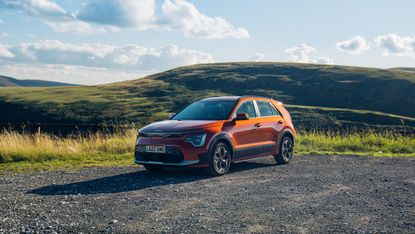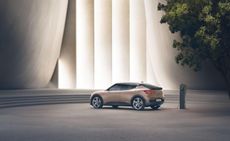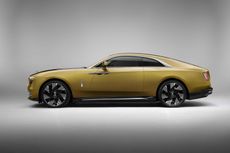Kia Niro EV combines quiet competence with engaging modern design
The Kia Niro EV sets a new standard for compact electric cars, with sophisticated design, impressive range and plenty of equipment
- (opens in new tab)
- (opens in new tab)
- (opens in new tab)
- Sign up to our newsletter Newsletter

Do you really care passionately about cars? Are you a self-described ‘petrolhead’? Does the sound of a throaty exhaust trigger some kind of automotive ASMR deep inside you? If you’ve clicked on a story about the new Kia Niro EV then you probably won’t answer ‘yes’ to any of those questions.

Kia’s Niro EV is a car for those who firmly believe that four-wheeled transportation should just do its job and not over-commit to extraneous baggage like ‘brand DNA’, personality, spirit, verve, or what-have-you. Kia has evolved into a very straight down the line company, seemingly more committed than ever to unfussy design and easy functionality.

The new Niro exemplifies this approach. Available as a conventional hybrid, a plug-in hybrid and a pure EV, as tested here, it’s a modest-sized hatchback that is externally unfussy and internally accommodating. A simple two-tone paint job makes the EV stand apart from the hybrids, with daytime running lights marking out the extremeties of the ‘tiger face’ front end, a signature Kia look.

The Niro does a lot of things extremely well. It’s easy to drive, thanks to a sensible scale and good visibility. It rides well, cloaking the weight of the battery with well-tuned suspension and deft steering. Inside, there are well laid-out switches and infotainment screens that don’t bamboozle with unnecessary complexity. It’s also very well equipped, with heated and cooled seats to avoid using the battery-draining aircon, and the ability to power electrical devices like vacuum cleaners and laptops from the main battery.

Kia has made good use of the innate power of an EV. The car generates the equivalent of 201bhp, giving it a welcome boost in ‘sport’ mode, as well as a claimed 285 mile range – expect about 80-90 per cent of this in normal, everyday use.

In many respects, Kia has now manoeuvred itself into a similar position that Audi and BMW held at the turn of the century, when the German brands were jostling for the role of design and technology leader in a car industry driving relentlessly upmarket. However, the type of tech that once defined ‘premium’ is now thoroughly mainstream, and a strong, idiosyncratic design and thorough, reliable engineering is more appealing than the power of a badge.

Built to exacting specifications in South Korea on a new platform (the Electric-Global Modular Platform, or E-GMP, architecture), the Niro EV is one of 14 EV models the company will launch be launching by 2027. EVs currently make up nearly a third of Kia’s current UK sales, and cars like the Niro will no doubt boost that percentage.
Also on the horizon are a speedier GT version of the excellent Kia EV6 (which replaces the old-school but swift and elegant Kia Stinger), as well as a production version of the Tonka Toy-like EV9 electric SUV concept.
By not adopting the conventional metrics of premium cars – performance and luxury – Kia is quietly transforming the middle ground.
Kia Niro EV, from £36,795
kia.com (opens in new tab)
Jonathan Bell has written for Wallpaper* magazine since 1999, covering everything from architecture and transport design to books, tech and graphic design. He is now the magazine’s Transport and Technology Editor. Jonathan has written and edited 15 books, including Concept Car Design, 21st Century House, and The New Modern House. He is also the host of Wallpaper’s first podcast.
-
 This winter’s most stylish skiwear, Gucci to Hermès
This winter’s most stylish skiwear, Gucci to HermèsStatement-making skiwear for on and off the slopes, from Louis Vuitton, Dior, Moncler and more
By Jack Moss • Published
-
 Clásicos Mexicanos celebrates Mexican design’s golden age
Clásicos Mexicanos celebrates Mexican design’s golden ageDesign Miami 2022: the Maestro Dobel Artpothecary in collaboration with Clásicos Mexicanos features works from Mexican architect Ricardo Legorreta’s ‘Vallarta’ collection
By Sujata Burman • Published
-
 HTL Africa imagines architecture as an ‘object of performance’
HTL Africa imagines architecture as an ‘object of performance’HTL from Nigeria is next up in our series of profiles of architects, spatial designers and builders shaping West Africa’s architectural future
By Ijeoma Ndukwe • Published
-
 Everrati announces a transformed, all-electric Range Rover Classic and Land Rover Defender
Everrati announces a transformed, all-electric Range Rover Classic and Land Rover DefenderBritish company Everrati now transforms the iconic Range Rover Classic and Land Rover Defender into high-end, go-anywhere electric vehicles
By Jonathan Bell • Published
-
 Cupra Born: new arrival is one of the best compact EVs on the market
Cupra Born: new arrival is one of the best compact EVs on the marketThe new Cupra Born embodies characterful design and the spirited zip of electric driving
By Jonathan Bell • Published
-
 Two new electric off-roaders – Munro Mk1 and Fering Pioneer – embody the spirit of adventure in sharp-edged, minimal suits
Two new electric off-roaders – Munro Mk1 and Fering Pioneer – embody the spirit of adventure in sharp-edged, minimal suitsThe Munro Mk1 and Fering Pioneer are designed to go anywhere, electrically. We check out the next generation of utility vehicles
By Jonathan Bell • Last updated
-
 Revived cult classic all-electric Moke makes it to the States
Revived cult classic all-electric Moke makes it to the StatesAn all-new electric version of the original Mini Moke harks back to its roots with a limited-edition Californian model
By Jonathan Bell • Published
-
 Volvo EX90 brings electrification to the upper end of the Volvo range
Volvo EX90 brings electrification to the upper end of the Volvo rangeA full-sized seven-seater, the all-new Volvo EX90 is the Swedish company’s safest and most sophisticated SUV to date
By Jonathan Bell • Published
-
 Piip is a playful electric car designed by artist Harald Thys
Piip is a playful electric car designed by artist Harald ThysPiip by Harald Thys and Lowie Vermeersch is a speculative project for a friendly electric family car, presented at the Maniera Gallery in Brussels
By Jonathan Bell • Published
-
 The Genesis GV60 marks a new era for electrified luxury
The Genesis GV60 marks a new era for electrified luxuryThe Genesis GV60 is one of the best EVs you can buy, a clean-sheet EV that puts the Korean luxury brand firmly on the map
By Jonathan Bell • Published
-
 The new Rolls-Royce Spectre glides into view
The new Rolls-Royce Spectre glides into viewRolls-Royce’s first-ever EV is a big moment for the brand. The Spectre retains the brand’s trademark sense of occasion and sheer physical scale without an exhaust pipe in sight
By Jonathan Bell • Last updated










